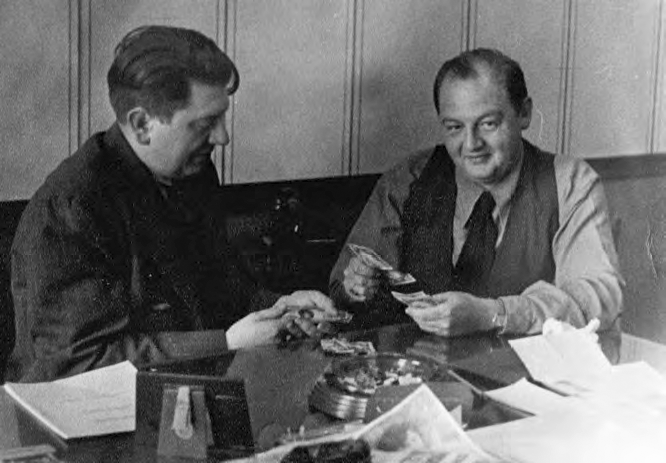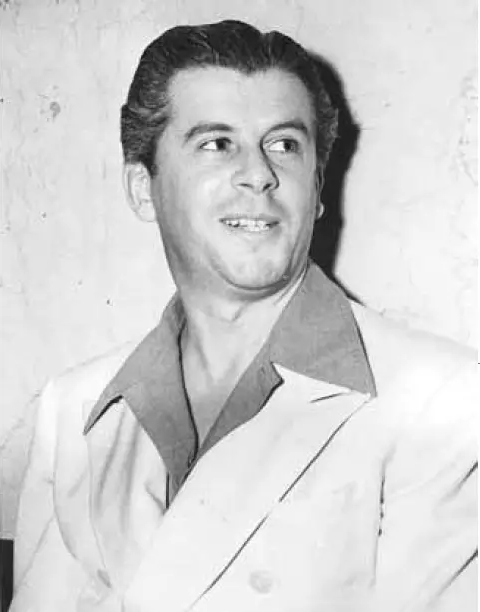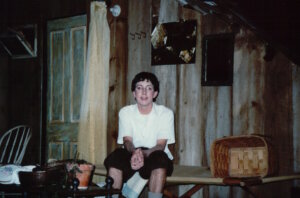Features
A deep dive into the lives of some shadier members of our community

By BERNIE BELLAN A few weeks ago I was contacted by a publicist for a publishing company, who asked me whether I’d be interested in obtaining a copy of a new book, titled Jukebox Empire: The Mob and the Dark Side of the American Dream?
Here’s what that publicist wrote: “This fall, Rowman & Littlefield is publishing a true crime book focusing on one of the key figures in the story of organized crime in the 20th century – Jukebox Empire: The Mob and the Dark Side of the American Dream by David Rabinovitch (publishing October 15). Rabinovitch, an award-winning filmmaker from Morden, Manitoba, unravels the story of his uncle William “Wolfe” Rabin, which takes him from the Canadian prairies to Chicago in the 1940s and Rabin’s invention of a jukebox. This is the first book to expose how organized crime infiltrated the jukebox industry and it’s an untold piece of criminal, cultural, and musical history. Rabin was the son of Jewish immigrants.

“Caught between the Mob and the feds in a plot to save the casinos in Havana from Castro’s revolution, Wolfe Rabin pulled the biggest money-laundering scheme in history, but his hubris led to the conspiracy falling apart in a sensational trial. At a time when there was a jukebox in every restaurant, diner, bar, barracks, arcade, and canteen, Rabin’s trajectory from inventor to promoter to outlaw is set against the Mob’s growing influence of the jukebox industry. In a world of music, machines, and money, popular culture and organized crime collide in this true story of invention and greed. Rabinovitch pieces together the puzzle that begins in Chicago and spans the casinos of Havana and the financial giants of Europe, leading to what the FBI called “the biggest bank robbery in the world.”
“Rabinovitch is a winner of Emmy, Peabody, and Gemini awards. His significant films include the documentary Politics of Poison and the mini-series Secret Files of the Inquisition. Jukebox Empire is his first book.”
Of course, the moment I read that email I was interested in reading the book. Here we have some of the essential elements of a story that’s perfect for this paper: A crime story with a Jewish character at its centre – who comes from Morden, Manitoba no less!
I immediately thought of historian Allan Levine, who’s written extensively about Jewish characters with sordid backgrounds – especially in the bootlegging business, and contacted Allan to ask him whether he’d ever heard of this “Wolfe Rabin?”
Allan said he hadn’t previously, not that is, until he was contacted by the author, David Rabinovitch, who asked Allan for some help.
After I began to read the book, however, I was again contacted by the publicist, who asked me to withhold writing a review of the book until October, when the book will be released to the public.
But, to whet readers’ appetites even further, here are some endorsements David Rabinovitch has already received in advance of the book’s actual release to the public:
“A fast-paced, colorful romp through a slice of the twentieth century American underworld”
-David Kertzer, Pulitzer Prize winner
“Jukebox Empire reads like a novel but the characters and events are real and chilling.”
-Peter Edwards, co-author, The Encyclopedia of Canadian Organized Crime
“It has everything: action, incredible characters, suspense, humor. Can’t wait to see the movie.”
-Fred Fuchs, producer, The Godfather, Part III
“A compelling story of family and crime that touches on key events of U.S. history in the 1950s and 60s”
-Scott M. Deitche, author, Garden State Gangland
“An eye-opening, informative, and fascinating book. Jukebox Empire is must-read.”
-Antonio Nicaso, author, Made Men, The Dark Mafia, Angels Mobsters & Narco-Terrorists
“A delightfully entertaining story of jukeboxes, money laundering, and stolen bonds.”
-Alex Hortis, author, The Mob and the City
“A unique combination of family memoir and investigative journalism.”
-Gary Jenkins, producer/host, “Gangland Wire”
“A tour-de-force account of the Mob’s growing infiltration into legitimate American industry and how it affected one man who was obsessed with power and money at all costs.”
-Joe Saltzman, Prof. of Journalism, Annenberg School of Communication, University of Southern California
I also asked David Rabinovitch whether readers could order Jukebox Empire in advance, so that they could obtain a copy as soon as it’s released.
David responded: The book “is available for pre-order online through the website www.jukeboxempire.com (Chapters Indigo in Canada) or readers should request it at their favourite bookstore.”

All this got me to thinking: Over the years, we’ve published quite a few stories about Jews with mob connections, and some of those individuals came from Winnipeg. Perhaps the story that elicited the most interest was one we published in 2015 by Martin Zeilig about a character by the name of Al Smiley. (You can still find that story on our website’s online archive. Just search for “Al Smiley.” in the “search archive” button on jewishpostandnews.ca)
Smiley, it turns out, was best friends with Bugsy Siegel (whose real name was Benjamin – and who hated being called “Bugsy.”) In fact, Smiley was sitting right beside Siegel – on his living room couch in his Las Vegas home, when Siegel was shot and killed by a Mafia hitman.
That story led to another story about a mobster with a Winnipeg connection who, it turns out, was actually related to me in a very distant way, someone by the name of Harry Altman.
In 2020 I wrote about someone by the name of John Novick in an article I wrote about the children of Jewish mobsters. In that same article I referenced Myer Lansky and his daughter, Sylvia, who was the subject of one of the greatest interviews Anna Maria Tremonti ever conducted when she was host of CBC’s “The Current.” (You can still listen to that interview on the CBC website.)
Finally, a few years back I happened to attend a Fringe show which was titled “Davey the Punk.” The creator of that show – and its sole performer, was singer Bob Bossin (who was a member of a well-known group called “String Band.”) The show was about Bob’s father, Davey Bossin who, while not a “made man” per se (Mafia parlance for someone who is accepted into the Mafia), but who was very “connected” and about whose background Bob Bossin knew nothing until years after his father had died.
What’s my obsession with mobsters, you might ask? Well, I don’t think I’m much different than a great many others when I say that I’m both fascinated and repelled by all these figures – and the fact they’re all Jewish only adds to my interest.
But, it got me to thinking – once again: Where are the stories about Winnipeg Jewish hoodlums from the North End? Even in Russ Gourluck’s masterful history of Winnipeg’s North End, The Mosaic Village, he only mentions two shady characters: Stanley Zedd, a well-known operator of gambling establishments, especially the Margaret Rose Tea Room on Osborne, and Bll Wolchuk, a major bootlegger in the 1920s.

So – to find out more about Jewish hoodlums of a bygone era, I turned to my most trusted source on the subject: Ernie Chisick, whom I first met at the Y reunion in 2019.
For those who don’t know Ernie – he is a raconteur of the first order and his own brushes with the law when he was younger only add to his mystique.
I sat down with Ernie one recent evening and asked him to repeat some of the fabulous stories he’s told me over the years about colourful North End characters with whom he crossed paths over the years. I was especially keen on hearing Ernie recite some of the nicknames of guys with whom he associated when he was younger.
The problem is, as Ernie explained, some of those individuals are still alive and, even if they’re not, they have kids and grandkids, so referring to them by their full names might not even be embarrassing, it might be potentially lethal for me!
I have attempted to reach out to one character in particular who, as Ernie described him, probably knows more about Jewish hoodlums… and criminals, from the North End of the 40s and 50s than anyone else alive, but even if that guy does get back to me, I rather doubt he’s going to want to see his name end up in the Jewish paper in Winnipeg. (I’m hoping that he will respond to my message and I’ll promise him full anonymity if he’s prepared to talk about his former friends – who weren’t quite boy scouts.)
Ernie though, has too many good stories not to at least refer to some of them here. He told me about a gambling club on Selkirk Avenue between Salter and Powers that was run by an individual who was known as “Montreal…..” (Again, I’m leaving out the surname because it’s a name that would be familiar to at least some readers.)
According to Ernie, that club had a lookout by the name of “Srulik Flaxman.” When Srulik would spot a cop coming, he would shout to the guys who were in the back room: “Watch out – it’s the football shoes kimmen!” (Why he referred to cops as “football shoes,” Ernie didn’t know.)
Here’s another story Ernie tells – about a character who went by the name “One-eyed Connolly.”
“They’re playing cards,” Ernie says, “and Connolly says he’s got to take a piss.” But before he gets up to go to the bathroom, he leaves his cards on the table, then takes out his glass eye, puts it on the table, and says to the eye: “Watch them guys; they’re all a bunch of thieves!” Apparently that so unnerved the other players, they sat there frozen in their seats, afraid of that well-known Jewish superstition: “the evil eye.” (But Connolly wasn’t Jewish. Can a non-Jew threaten someone Jewish with the “evil eye?” There’s a Saturday morning sermon for you, all you rabbis and would-be rabbis out there.)
With reference to Stanley Zedd and the Margaret Rose Tea Room, Ernie says that his father, Charlie, once said to him, “Take this to the Rosie (the nickname for the Osborne Tea Room) and ask for Stanley Zedd.” Charlie handed Ernie a paper bag (which, Ernie now says, unbeknownst to him at the time, contained betting slips. Ernie claims he was only an innocent 16-year-old. not yet wise in the ways of the world. Anyway, the statute of limitations protects him now.)
So, Ernie drove to the Tea Room and announced, when he walked into the room, “I have something for Stanley from Charlie.”
He was ushered into the back room where Stanley Zedd held court. “He was very nice to me and told me my father was an honourable man,” Ernie recalls.
Another time, Ernie says, he got a phone call from his father in the middle of the night.
“Charlie,” Ernie asked (Ernie says he always called his father by his first name), “what is it?”
“I’m in jail,” Charlie responded. (He didn’t say why.)
“In the morning,” Charlie continued, “give Roland Penner a phone call.” (Roland Penner would go on to become Manitoba’s attorney general, but at the time he was in partnership with Joe Zuken in the firm, Zuken and Penner.)
“So, I phoned Roland Penner’s office in the morning. I told his secretary who I was and she put me through immediately to Roland Penner.”
“Roland says to me, ‘You heard from your dad? The mounties made a raid in the middle of the night. Eighteen guys (from different cities) were charged with conspiracy to commit bookmaking.’”
“Roland says: ‘I’ve got something for you.’ “ He explained that the mounties took Charlie out in the middle of the night and it was quite cold.
“Your father wanted me to give you his gloves,” Penner continues.
“I put them on,” Ernie says, “and I feel a lump in one of the gloves. They were betting slips that could have been used as evidence in court.’
(Did Penner know that, I wonder? Ernie says he doesn’t know.)
“All the guys were taken to a lock-up in Calgary. Harry Walsh represented the three Winnipeggers,” Ernie continues.
“My dad explained that the Jewish boys were able to get kosher food to eat because one of the mounties was Jewish and he brought them deli.”
The Grey Cup was being held that week, Ernie says. “Charlie said he made $10,000 taking bets on the game” – while he was in jail.
Eventually, when the accused were brought to trial, they were all acquitted, Ernie explains.
“Walsh said they weren’t betting with each other; they weren’t in business together.” As a result, the conspiracy charge didn’t hold up, Ernie says. (If they had simply been charged with bookmaking, then the likelihood is that at least some of them, including Charlie, would have been found guilty.)
I don’t necessarily approve of Charlie’s behaviour. Rather, the stories about the less savoury aspects of Jewish lives don’t usually receive much attention in North American Jewish newspapers. (Some Israeli newspapers, in contrast, are not at all reluctant to publish extensive investigative pieces about the Israeli underword.)Yet, there are so many colourful stories to tell I thought I’d deviate from the Gerry Posner and Myron Love types of stories that extol the virtues of individuals who have led honest, hardworking lives to write about other less honourable fellows who, as the late Harvey Rosen used to say are “of the Hebraic persuasion.”
We’ll have more about members of our community who had connections to activities that were not always on the right side of the law in our Aug. 16 issue. If you might have a story to add about a relative with a shady past that you might like to share, you can email us at jewishp@mymts.net
Features
Optimizing mobile wagering convenience with bassbet casino

The rise of mobile technology has transformed the way people engage with betting platforms. In this digital era, bassbet has emerged as a frontrunner in optimizing mobile experiences for casino enthusiasts. This article explores how bassbet casino is enhancing mobile wagering convenience.
Mobile technology has revolutionized the betting industry, providing users with unprecedented convenience and accessibility. Bassbet casino has capitalized on this trend by offering a seamless mobile wagering experience. By integrating user-friendly features and cutting-edge technology, the platform ensures that it is both accessible and engaging for users on the go.
Enhancing user experience with mobile technology
Bassbet casino leverages the latest mobile technology to enhance user experience. The platform’s intuitive design and easy navigation make it simple for users to place bets from their mobile devices. This focus on user experience ensures that players can enjoy their favorite games without any hassle.
Furthermore, the platform offers a wide range of games optimized for mobile play, ensuring that users have access to the same variety and quality as they would on a desktop. This adaptability is crucial in maintaining user engagement and satisfaction, as it allows players to enjoy their gaming experience anytime, anywhere.
The responsive design philosophy adopted by the platform ensures that every element of the platform scales perfectly across different screen sizes and device types. Whether users are accessing the casino through smartphones or tablets, the interface automatically adjusts to provide optimal viewing and interaction. This technological sophistication extends to touch-optimized controls, swipe gestures, and quick-loading graphics that minimize data consumption while maximizing visual appeal. The platform also incorporates intelligent caching mechanisms that remember user preferences and frequently accessed games, creating a personalized mobile environment that becomes more intuitive with each visit.
Security and reliability in mobile wagering
Security is a top priority for bassbet casino, especially when it comes to mobile wagering. The platform employs advanced security measures to protect user data and ensure safe transactions. This commitment to security builds trust among users, making it a reliable choice for mobile betting.
In addition to security, the company focuses on providing a reliable and stable platform. The casino’s mobile interface is designed to handle high traffic and deliver a smooth gaming experience, minimizing disruptions and ensuring that users can enjoy uninterrupted play.
Innovative features for mobile users
The company continuously innovates to offer unique features tailored for mobile users. From personalized notifications to exclusive mobile promotions, the platform ensures that its mobile users receive a premium experience. These features not only enhance user engagement but also encourage loyalty among players.
By staying at the forefront of mobile technology, the platform remains a leader in the online betting industry. Its commitment to optimizing mobile wagering convenience sets it apart from competitors, making it a preferred choice for casino enthusiasts worldwide.
Features
Why People in Israel Can Get Emotionally Attached to AI—and How to Keep It Healthy
Let’s start with the uncomfortable truth that’s also kind of relieving: getting emotionally attached to a Joi.com AI isn’t “weird.” It’s human. Our brains are attachment machines. Give us a voice that feels warm, consistent, and attentive—especially one that shows up on demand—and our nervous system goes, “Oh. Safety. Connection.” Even if the rational part of you knows it’s software, the emotional part responds to the experience.
Now, if we’re talking about Jewish people in Israel specifically, it’s worth saying this carefully: there isn’t one “Jewish Israeli psychology.” People differ wildly by age, religiosity, community, language, politics, relationship status, and life history. But there are some real-life conditions common in Israel—high tech adoption, a fast-paced social environment, chronic background stress for many, and strong cultural emphasis on connection—that can make AI companionship feel especially appealing for some individuals. Not because of religion or ethnicity as a trait, but because of context and pressure.
So if you’ve noticed yourself—or someone you know—getting attached to an AI companion, the goal isn’t to panic or label it as unhealthy by default. The goal is to understand why it feels good and make sure it stays supportive rather than consuming.
Why attachment happens so fast (the psychology in plain language)
Attachment isn’t just about romance. It’s about regulation. When you feel seen, your body calms down. When you feel ignored, your body gets edgy. AI companions can offer something that’s rare in real life: consistent responsiveness. No scheduling. No misunderstandings (most of the time). No “I’m too tired to talk.” Just a steady stream of attention.
From an attachment perspective, that steadiness can act like a soft emotional “hug.” For someone with anxious attachment, it can feel like relief: finally, a connection that doesn’t disappear. For someone with avoidant tendencies, it can feel safe because it’s intimacy without the risk of being overwhelmed by a real person’s needs. For someone simply lonely or stressed, it can feel like a quiet exhale.
And unlike human relationships, AI won’t judge your worst timing. You can message at 2:00 a.m., when your thoughts are loud and the apartment is silent, and you’ll still get an answer that sounds caring. That alone is powerful.
Why it can feel especially relevant in Israel (for some people)
Israel is a small country with a big emotional load for many people—again, not universally, but often enough that it shapes daily life. A lot of people live with a background hum of stress, whether it’s personal, economic, or tied to the broader environment. When life feels intense, the appeal of a stable, gentle interaction grows. Not because you’re fragile—because you’re tired.
Add a few more very normal realities:
High tech comfort is cultural. Israel has a strong tech culture. People are used to tools that solve problems quickly. If you’re already comfortable with digital solutions, trying an AI companion doesn’t feel like a strange leap.
Time is tight. Between work, family responsibilities, reserve duty for some, long commutes, or simply the pace of urban life, many people don’t have the energy for long, messy social processes. AI can feel like connection without the logistics.
Social circles can be both close and complicated. Israeli society can be community-oriented, which is beautiful—until it’s also intense. In tight-knit circles, dating and relationships sometimes come with social pressure, opinions, and “everyone knows everyone.” A private AI chat can feel like a relief: no gossip, no explanations, no performance.
Language and identity complexity. Many Jewish Israelis move between languages and cultures (Hebrew, Russian, English, French, Amharic, Arabic for some). AI chat can become a low-stakes space to express yourself in the language you feel most “you” in—without feeling judged for accent, vocabulary, or code-switching.
None of this means “Israelis are more likely” in any absolute sense. It means there are situational reasons why AI companionship can feel particularly soothing or convenient for some people living there.
The good side: when AI attachment is healthy
Emotional attachment isn’t automatically a problem. Sometimes it’s simply a sign that something is working: you feel supported. You feel calmer. You’re expressing yourself more. You’re practicing communication instead of shutting down. You’re less likely to make impulsive choices from loneliness.
Healthy use often looks like:
You feel better after chatting, not worse.
You can still enjoy your real life—friends, work, hobbies, family.
You don’t hide it in shame; you just treat it like a tool or pastime.
You use the AI to practice skills you bring into real relationships: clarity, boundaries, confidence, emotional regulation.
In that version, AI companionship is closer to journaling with feedback, or a comforting ritual—like a cup of tea at the end of the day, not a replacement for dinner.
Where it can slip into unhealthy territory (quietly)
The danger isn’t “having feelings.” The danger is outsourcing your emotional world to something that will never truly share responsibility.
Warning signs usually look like:
You cancel plans with humans because the AI feels easier.
You feel anxious when you’re not chatting, like you’re missing something.
You start needing the AI to reassure you constantly.
Your standards for human relationships collapse (“Humans are too complicated, AI is enough”).
You feel a “crash” after chatting—more lonely, more restless, more disconnected.
The biggest red flag is when the AI becomes your only reliable source of comfort. That’s not because AI is evil. It’s because any single source of emotional regulation—human or non-human—can become a dependency.
How to keep it healthy (without killing the fun)
Here’s the approach that works best: don’t ban it, contain it.
Give it a role.
Decide what the AI is for in your life: playful flirting, stress relief, practicing communication, roleplay, bedtime decompression. A defined role prevents the relationship from becoming vague and all-consuming.
Set a “time container.”
Not as punishment—just as hygiene. For example: 20 minutes at night, or during commute time, or only on certain days. Ending while you still feel good is the secret. Don’t chat until you feel hollow.
Keep one human anchor active.
A friend you text, a weekly family dinner, a class, a gym routine, a community event—something that keeps your real social muscles moving. In Israel, community can be a huge protective factor when it’s supportive. Use it.
Use consent and boundary language even with AI.
It sounds odd, but it trains your brain in healthy dynamics:
“Slow down. Keep it playful, not intense.”
“No jealousy talk. I don’t like that vibe.”
“Tonight I want comfort, not advice.”
If you can do that with an AI, you’ll be better at doing it with humans.
Watch the “replacement” impulse.
If you catch yourself thinking, “I don’t need anyone else,” pause and ask: is that empowerment—or is it avoidance? Sometimes it’s a protective story your brain tells when it’s tired of disappointment.
Check in with your body after.
Not your thoughts—your body. Calm? Lighter? More grounded? Good sign. Agitated? Empty? Restless? Time to adjust.
And if you’re noticing that AI use is feeding anxiety, sleep problems, isolation, or obsessive thinking, it may help to talk to a mental health professional—especially someone who understands attachment patterns. That’s not a dramatic step. It’s basic self-care.
People in Israel—Jewish Israelis included—can get attached to AI for the same reason people everywhere do: it offers consistent attention in an inconsistent world. Add the local realities of stress, pace, and social complexity, and it can feel even more comforting for some individuals. The healthiest path isn’t to judge yourself for it. It’s to use it intentionally, keep your human life active, and treat the AI as a supportive tool—not the center of your emotional universe.
Features
Three generations of Wernicks all chose to become rabbis

By GERRY POSNER Recently I was at a Shabbat service at Beth Tzedec Synagogue in Toronto and the day unfolded in some unexpected ways for me.
It began when I was asked to be a Gabbai for the service, that is to stand up at the table where the Torah is placed and to check the Torah reading to make sure there are no errors. I have done this before and it has always gone smoothly. I attribute that fact in large part to the Torah reading ability of the reader at Beth Synagogue. He is fast, fluent and flawless. Well, on this particular day after he had completed the first two portions, he began the shlishi or third aliyah. I could not find his reading anywhere. It was as if he had started somewhere fresh, but not where he was supposed to be. I looked at the other Gabbai and he did not seem to recognize what had happened either. So, I let it go. I had no idea where the Torah reader was. He then did another and still I was lost. He came to what was the 6th aliyah when a clergy member walked over to him and indicated to him that he had read the fourth and fifth aliyah, but that he had missed the third one. The Torah reader then said to me “this is what you are here for.” Now, it might have been one thing if I had missed it entirely. Alas, I saw the error, but let it go as I deferred to the Torah reader since he never makes a mistake. He ended up going back to do the third aliyah before continuing on. This was a very unusual event in the synagogue. I felt responsible in large part for this gaffe. A lesson learned.
The feeling of embarrassment was compounded by the fact that on this particular day the service was highlighted, at least for me, because of the rabbi delivering the sermon. This rabbi, Eugene Wernick, was none other than the father of my present rabbi, Steven Wernick of Beth Tzedec Synagogue. He was also the same rabbi who was the rabbi at Shaarey Zedek between 1979-1986 and who had officiated at my father’s funeral in 1981, also a few years later at my oldest son’s Bar Mitzvah in Winnipeg in 1984. As I listened to him speak, I was taken back to the 1980s, when Rabbi Gene was in the pulpit at Shaarey Zedek. Of course, he is older now than in his Shaarey Zedek days, but the power of his voice was unchanged. If anything, it’s even stronger. As in the past, his message was relevant to all of us and resonated well. Listening to him was a treat for me. Still, my regret in not calling out the mistake from the Torah reading was compounded by the fact that I messed up in front of my former rabbi, Eugene Wernick – never mind my present rabbi, Steven Werinck.
On this Shabbat morning, aside from all the other people present, there were not only the two Rabbis Wernick, but one Michelle Wernick was also there. Michelle, daughter of Rabbi Steven Wernick, is a first year student at the Jewish Theological Seminary. She is following in the family business – much like with the Rose rabbinical family in Winnipeg.
As it turned out, there was a Bat Mitzvah that day. And the Bat Mitzvah family had a very real Winnipeg connection as in the former Leah Potash, mother of the Bat Mitzvah girl, Emmie Bank and the daughter of Reuben and Gail Potash (Thau). It occurred to me that there might be a few Winnipeg people in the crowd. As I scanned the first few rows, I was not disappointed. Sitting there was none other than Chana Thau and her husband Michael Eleff. I managed to have a chat with Chana (even during the Musaf service). In the row right behind Chana and Michael was a face I had not seen in close to sixty years. I refer to Allan Berkal, the eldest son of the former rabbi and chazan at Shaarey Zedek, Louis Berkal. I still remember the first time I met Allan at Hebrew School in 1954 when his family moved to Winnipeg from Grand Forks, North Dakota. That was many maftirs ago. So this was another highlight moment for me.
Of course, there are other Winnipeggers who attend Beth Tzedec most Shabbats. I speak of Morley Goldberg and his wife, the former Marcia Billinkoff Schnoor. As well, Bernie Rubenstein and his wife, the former Sheila Levene were also present for this particular Shabbat. In all, this Shabbat had a particularly Winnipeg flavour to it. Truth be told, you do not have to go far in Toronto at any synagogue and the Winnipeg connections emerge.






